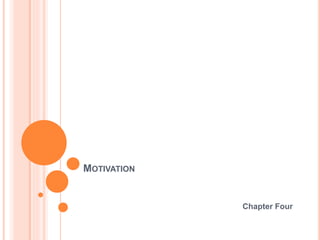
What Drives Employee Motivation
- 2. WHAT IS MOTIVATION It is the set of internal and external forces that cause an employee to choose a course of action and engage in certain behaviors, ideally, these behaviors will be directed at the achievement of an organizational goal. work motivation is a complex combination of psychological forces within each person and employers are vitally interested in three elements of it: 1. Direction and focus of the behavior 2. Level of the effort provided 3. Persistence of the behavior
- 3. MODELS OF MOTIVATION Needs and drives Tension rewards Performance effort Environment Opportunity Ability Goals &incentives Need satisfaction
- 4. Motivational drives affect the way people view their jobs and approach their lives. There are three drives: 1- achievement motivation : is a drive some people have to pursue and attain goals. A drive to accomplish objectives and get ahead. The achievers control their destiny, seek regular feedback and enjoy being part of a winning achievements through individual or collective effort. 2- Affiliation: is a drive to relate to people on social basis. Affiliation oriented managers may have difficulty assigning challenging tasks, directing work activities and monitoring work effectiveness. 3- Power: is a drive to influence people, take control, and change situations. Power motivated people wish to create an impact on their organizations and are willing to take risks to do so.
- 5. HUMAN NEEDS Types of needs : there are basic physical needs which are called primary needs and psychological needs called secondary needs. The physical needs include food, water, sex, sleep, air and reasonably comfortable temperature. The secondary needs are more vague because they represent needs of the mind and spirit rather than of the physical body. These needs are developed as people mature. Examples are needs that pertain to self esteem, sense of duty , self assertion and belonging. The secondary needs are : Strongly conditioned by experience Vary in type Subject to change Cannot be isolated Are often hidden from conscious recognition Influence behavior in powerful ways.
- 6. Maslow hierarch of needs Herzberg model Alderfer ERG model Self actualization Work itself achievement possibility of growth responsibility Growth needs Esteem and status needs Advancement recognition Relatedness needs Belonging and social needs Status Relations with supervisors Peer relations Relations with subordinate Quality of supervision Existence needs Safety and security needs Company policy and administration Job security Physiological needs Working conditions pay
- 7. Maslow needs :the first two levels are considered lower order needs, the other levels are considered higher order needs. Herzberg’s two factor model : maintenance and motivational factors. The maintenance factors are hygiene factors because they must not be ignored. They are necessary for building a foundation on which to create a reasonable level of motivation in employees. Other job conditions operate primarily to build this motivation but their absence rarely is strongly dissatisfying. These conditions are motivational factors. Motivators mostly are job centered they relate to job content. On the other hand, the maintenance factors are elated to job context. Intrinsic motivators are internal rewards that a person feels when performing a job so there is a direct and often immediate connection between work and rewards. extrinsic motivators are external rewards that occur apart from the nature of work, provide no direct satisfaction at the time the work is performed.
- 8. Alderfre’s ERG model: 1- Existence needs: which combine psychological and security factors, pay, job security and physical working conditions. 2- Relatedness needs: involve being understood and accepted by people above, below and around the employee at work. 3- Growth needs: involve the desire for both self esteem and self actualization.
- 9. Expectancy model : it is developed by Victor Vroom explains that motivation is a product of three factors : how much one wants a reward (valence), one’s estimate of the probability that effort will result in successful performance (expectancy), and one’s estimate that performance will result in receiving the reward (instrumentality) Valence x expectancy x instrumentality = motivation Valence: refers to the strength of a person’s preference for receiving a reward. Expectancy: is the strength of belief that one’s work related effort will result in completion of a task. Instrumentality: represents the employee’s belief that a reward will be received once the task is accomplished.
- 10. The Equity model: it states that employees tend to judge fairness by comparing the outcomes they receive with their relevant inputs and also by comparing this ratio with the ratios of other people. One’s own outcomes = other’s outcomes one’s own inputs other’s inputs The inputs include all rich and diverse elements that employees believe they bring or contribute to the job- their education, seniority, loyalty and commitment, time and effort. The outcomes: are rewards they perceive they get from their jobs and employers , outcomes include direct pay and bonuses, social rewards, and job security.
- 11. POSSIBLE REACTIONS TO PERCEIVED INEQUITY Type of inequity reaction Possible over reward reaction Possible under reward reaction Internal , physical Work harder Lower productivity Internal, psychological Discount the reward Inflate value of the reward External, physical Encourage the referent Bargain for more possibly quit External ,psychological Person to obtain more change the referent person Change the referent person